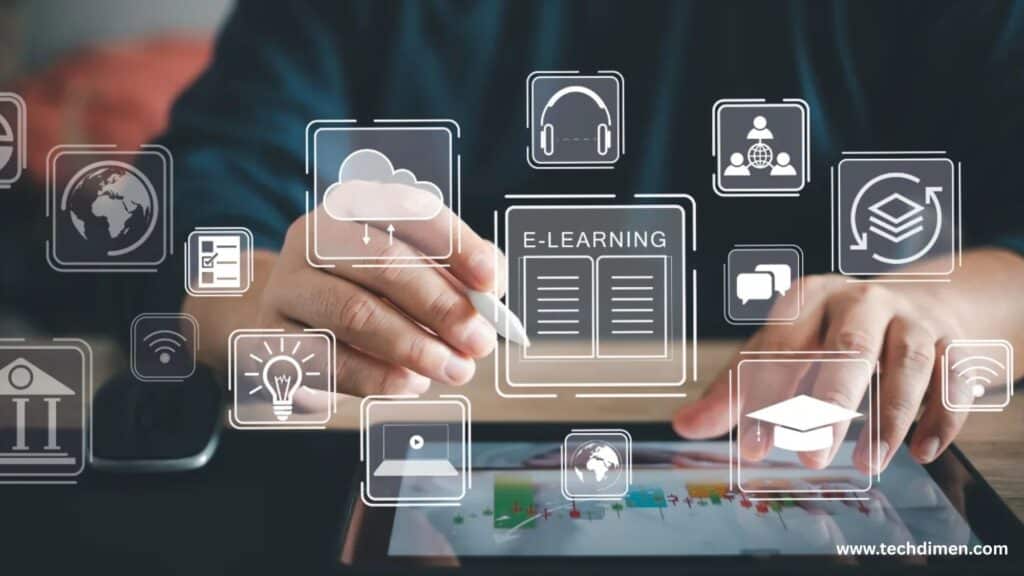Educational technoclogy and instructional design, The rapid transformation of the educational landscape has made the integration of educational technology and instructional design more important than ever. With the rise of online learning platforms and the shift toward digital classrooms, educators and organizations must approach learning with both innovation and structure. The synergy between cutting-edge EdTech tools and strategic instructional planning is essential to meet the demands of modern learners.
The Critical Role of educational technoclogy and instructional design

The global pivot to remote teaching, particularly post 2020, has exposed the strengths and shortcomings of digital education. Many institutions discovered that merely digitizing content does not guarantee effective learning. To truly engage students and support meaningful outcomes, digital tools must be integrated thoughtfully through sound instructional design strategies. By merging technology with learner-centered design principles, educators can automate repetitive tasks, personalize instruction, and provide adaptive learning experiences grounded in real-time feedback and learning analytics.
Educational Technology
Educational technology encompasses more than hardware and software. It includes a wide spectrum of platforms and tools designed to enhance the teaching and learning process. Learning management systems such as Moodle, Canvas, and Blackboard serve as foundational hubs for managing and delivering educational content. Mobile learning applications enable flexibility, allowing learners to engage with content anytime and anywhere. Simulation software and virtual reality environments introduce experiential learning, immersing students in real-world scenarios.
These tools support diverse instructional strategies such as blended learning, flipped classrooms, and adaptive learning. The key objective is to improve accessibility, personalize learning paths, and measure student engagement and performance through data-driven insights. Effective EdTech tools are scalable and support collaborative, inclusive, and student-centered learning experiences.
The Blueprint of Effective Learning

Instructional design is the structured process of creating educational experiences that support learning goals and maximize retention. It is informed by research in cognitive psychology, pedagogy, and user experience. One widely adopted framework is the ADDIE model, which stands for Analysis, Design, Development, Implementation, and Evaluation. This model provides a systematic approach to identifying learner needs, crafting instructional objectives, creating content, delivering it through appropriate platforms, and assessing its effectiveness.
Other popular models include the Successive Approximation Model (SAM), which emphasizes rapid prototyping and iterative development, and Backward Design, which begins with identifying desired learning outcomes and then planning assessments and instructional activities accordingly. Instructional designers often rely on Bloom’s Taxonomy to structure learning objectives across cognitive levels, from basic recall to complex problem-solving.
Cognitive load theory and multimedia learning principles further guide content development. These principles suggest minimizing extraneous information, chunking content into digestible segments, and balancing multimedia elements to avoid overloading the learner’s cognitive capacity.
Integrating Educational Technology with Instructional Design

The integration of educational technology with instructional design requires alignment between tools and learning objectives. Rather than adopting technology for its novelty, instructional designers must evaluate whether a tool supports the intended learning outcomes. When done effectively, instructional designers act as learning engineers, continuously testing, refining, and evaluating content based on learner analytics and feedback.
Practical examples of this integration include the use of branching simulations in corporate onboarding programs, where learners explore scenarios and receive immediate feedback based on their decisions. In K-12 settings, tools like Nearpod facilitate interactive lessons that combine video, polling, and real-time quizzes. In higher education, massive open online courses (MOOCs) often integrate adaptive learning engines and peer assessments to enhance engagement and mastery.
Emerging Trends in Educational Technology and Instructional Design
Artificial intelligence is increasingly influencing educational delivery. AI-powered tutoring systems provide personalized instruction, while machine learning algorithms analyze student data to recommend resources tailored to individual needs. These advancements enable real-time feedback loops and scalable personalized learning experiences.
Microlearning, which involves delivering content in short, focused segments, supports better retention and fits well into the schedules of busy learners. This trend is particularly effective for mobile learning and just-in-time training, where learners need quick access to information.
Virtual and augmented reality technologies offer immersive learning experiences that simulate real-world environments. In fields like medicine, engineering, and science, VR enables students to practice skills and procedures in a risk-free environment. These tools enhance spatial understanding, empathy, and hands-on application.
The rise of learning analytics allows educators to track engagement, predict student performance, and identify at-risk learners. This data is crucial for refining instructional strategies and improving outcomes. As analytics tools become more sophisticated, they will play an increasingly central role in instructional design.
Best Practices for Implementation
Effective implementation begins with a thorough analysis of learner needs. Surveys, interviews, and performance data help identify gaps and inform decisions about which tools and strategies to employ. Accessibility must be a core consideration from the outset. Designing content that complies with WCAG 2.1 standards ensures that all learners, including those with disabilities, can access and benefit from digital resources.
Piloting new tools and instructional approaches with a small group before a full rollout allows for feedback and adjustment. This iterative approach ensures that issues are addressed early, and the final implementation is optimized for scale. Key performance indicators such as engagement rates, completion rates, and learner satisfaction should be tracked to evaluate effectiveness.
Educator training is also vital. Teachers and trainers must be equipped not only to use new technologies but to understand how they support pedagogical goals. Professional development opportunities, peer mentoring, and certifications in instructional design software help build confidence and competence.
Overcoming Common Challenges, educational technoclogy and instructional design
One common mistake is adopting technology without a clear instructional strategy. Tools should not dictate pedagogy; rather, pedagogy should inform tool selection. Addressing the digital divide is another major challenge. Ensuring that learners have access to devices, internet connectivity, and offline options is critical to equity.
Designing one-size-fits-all content often fails to meet the needs of diverse learners. Instruction should be personalized, offering multiple pathways and modalities. Learner personas, differentiated instruction, and scaffolding techniques can help tailor experiences to individual needs.
The Future of Learning
The future of educational technology and instructional design lies in creating human-centered learning experiences. This involves co-creating content with learners, conducting empathy-based research, and continuously refining based on feedback. Learner-owned data and decentralized credentialing systems powered by blockchain could transform how achievements are recognized and shared.
Ethical considerations will also become increasingly important. Privacy, consent, and data security must be prioritized. Designing for inclusivity and cultural responsiveness will ensure that educational innovations serve all learners effectively.
Benefits of Integrating educational technoclogy and instructional design
The integration of EdTech and instructional design leads to higher engagement, better retention, and more efficient learning. Interactive elements and gamification motivate learners, while adaptive systems adjust content to individual progress. Automation reduces administrative burdens, allowing educators to focus on teaching. Inclusive design practices support equitable access, and data driven strategies ensure continuous improvement.
Case Studies, educational technoclogy and instructional design
In the pharmaceutical industry, a company faced challenges in training its sales representatives. Traditional classroom sessions resulted in low retention and long training periods. By introducing microlearning modules and interactive role playing simulations, the company reduced training time by 40 percent and saw a 20 percent increase in sales performance.
In a public school district transitioning to hybrid learning, the integration of a robust LMS and regular virtual check-ins led to a 15 percent increase in student engagement and a 10 percent improvement in standardized test scores. These outcomes underscore the power of combining technology with thoughtful instructional design.
educational technoclogy and instructional design
| Tool | Purpose | Best For |
|---|---|---|
| Canvas LMS | Course structure, assessment | Higher education |
| Articulate 360 | Interactive course creation | Corporate training |
| Kahoot! | Gamified assessments | K–12 engagement |
| Google Classroom | Content sharing, management | Primary & secondary ed |
| Zoom | Live virtual instruction | Remote teaching |
FAQs
What is educational technology, and how does it improve learning?
Educational technology refers to tools and platforms that enhance teaching and learning. It improves learning by making lessons more interactive, accessible, and personalized.
How does instructional design differ from traditional teaching?
Instructional design focuses on systematically creating learning experiences based on learners’ needs and goals, while traditional teaching often follows fixed curricula without customization.
What are the key models used in instructional design?
The ADDIE model (Analysis, Design, Development, Implementation, Evaluation) is the most popular. Other models include SAM (Successive Approximation Model) and the Dick and Carey model.
Can educational technology be used effectively for remote learning?
Yes! EdTech tools like video conferencing, LMS platforms, and interactive apps make remote learning engaging and flexible.
What role does AI play in educational technology?
AI personalizes learning by analyzing student data to tailor content, provide real-time feedback, and automate administrative tasks.
How can educators ensure their online courses are accessible?
By following Universal Design for Learning (UDL) principles, using screen reader–friendly content, and providing captions for videos.
What are some common challenges when implementing instructional design?
Challenges include aligning content with learner needs, keeping learners engaged, and integrating technology smoothly without overwhelming users.
How does gamification improve student engagement?
Gamification uses game-like elements (points, badges, challenges) to motivate learners and make the experience fun and interactive.
What is the difference between synchronous and asynchronous learning?
Synchronous learning happens in real-time with live interaction, while asynchronous learning lets students access materials and complete work at their own pace.
How do instructional designers measure the effectiveness of a course?
They use evaluations like quizzes, surveys, and learning analytics to assess knowledge gain, learner satisfaction, and behavior change.
Conclusion
Educational technoclogy and instructional design, The most effective educational experiences arise not from technology alone, but from the strategic combination of educational technology and instructional design. By aligning tools with learning goals, designing with empathy, and evaluating outcomes with precision, educators can build learning environments that are engaging, inclusive, and impactful. As the field continues to evolve, staying informed about emerging trends and maintaining a focus on learner needs will be essential to shaping the future of education.

Jhon AJS is a tech enthusiast and author at Tech Dimen, where he explores the latest trends in technology and TV dimensions. With a passion for simplifying complex topics, Jhon aims to make tech accessible and engaging for readers of all levels.







